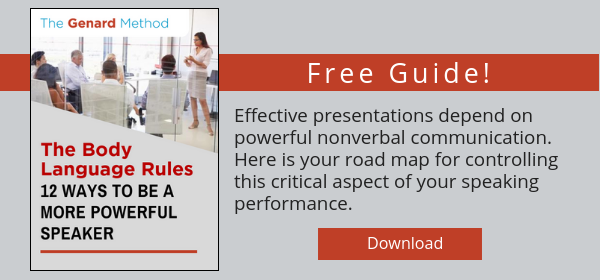There are no tricks to becoming a great speaker.
Yet, there are public speakers that seem like magicians.
Here are four ways you can add magic to your own speeches and presentations. The techniques I discuss below will lift you from the ordinary to a step closer to the extraordinary. Follow these suggestions and you may transform not only your own life as a speaker but also the lives of the audiences you influence.
Looking to speak with greater presence and charisma for leadership? To become recognized as an expert public speaker, download my free cheat sheet, "5 Ways to Captivate an Audience." Go beyond run-of-the-mill talks and presentations, and make both you and what you say memorable!
1. Tell Stories. Stories are not just something to add to a presentation to make it more interesting—they are the lifeblood of public speaking. People respond to stories in ways that the bare delivery of information can’t come close to equaling. Yet how often do we present content in just that way: as dry-as-toast data, bullet points, and items on an agenda?
If you want to persuade and influence audiences, you must take them on an emotional journey. And nothing engages and even fascinates listeners like a story. All of the human elements of challenges, motives, strivings, failures and triumphs come to life powerfully in stories. Find a way to make your information come alive in a story, and you’ll indeed be achieving something magical.
Choosing between explaining something and telling a story? Remember Lewis Carroll’s Alice’s Adventures in Wonderland:
'I could tell you my adventures—beginning from this morning,' said Alice a little timidly: 'but it's no use going back to yesterday, because I was a different person then.'
'Explain all that,' said the Mock Turtle.
'No, no! The adventures first,' said the Gryphon in an impatient tone: 'explanations take such a dreadful time.'
Want to tell great stories as a speaker? — Here's how!
2. Go with the Content You Have and Start Practicing. What I mean by this is, know when it’s time to stop amassing material and get up on your feet.
Think about how you prepare for a speech or presentation. — Is there a balance between the time you spend putting together content and the time you spend practicing? Most of us gather material—sometimes up to the last minute—then edit it, polish it, and perfect it according to the time we have available.
This method, of course, keeps us in the literary world of writing, rather than the oral world of a public speaking performance. Wouldn’t it save time if you spoke out loud what you intend to say early in the process, so that it comes out the way you want it to sound?
Your practice sessions are more than just rehearsals. They are getting you ready to perform in the oral arena. So spend less time putting together content, and more time on your feet. Assuming you know your job (and I’m sure you do!), you already have content coming out of your ears. What will serve you in your upcoming talk is being comfortable standing in front of an audience, knowing how to establish rapport with them and saying something that sounds right to their ears.
To achieve a match made in heaven—great material combined with a dynamic performance, download my free cheat sheet, “Great Speaking? — It’s About Performance Over Content!”
3. Get Your Body Into the Act. As 21st-century speakers, most of us fall victim to what I call the Talking Head Syndrome. We increasingly live in our heads, with too few demands for us to draw upon the physical dimensions of communication.
In previous centuries, you’d be speaking to those you were trying to influence outdoors, or at least in large public spaces. From farmers to merchants to homemakers to public figures, the need to project your sound and augment it with body language was a given. Cell phones, microphones, and audio and video platforms—along with team discussions around conference tables and business meetings at Starbucks—have eliminated some of the speaking habits we used to rely on.
Among the important elements that are being lost is the physical dimension of our presentations. But body language, gestures, posture, facial expressions, proximity, and all the other ways we use our body in communication, still matter. So get your body back in the act. Among the ways you can transform an ordinary speech into a memorable one, the use of physical expression is literally a no-brainer. Here are three ways you can energize your body language for leadership.
4. Disappear. And for the ne plus ultra of your public speaking magic act . . . disappear! Impossible in a speech or presentation given in public? Not at all—in fact, it’s something you should aim for every time you speak.
For many of us, perhaps most, speaking in public creates some level of anxiety, self-consciousness, and a strong desire to succeed in the eyes of others. All of those responses keep us focused on ourselves as we strive to give an excellent “performance.” But one thing I know as an actor is that aiming for a great performance keeps one on the surface of things, more concerned with the sizzle than the steak.
The epitome of great speaking concerns itself instead with something very different: disappearing into one’s message. You should in fact become a conduit to your message, and nothing else should concern you about your performance. When that happens, the “you” of all those concerns and anxieties vanishes, and what’s left is what should always have animated you: a focus on the needs of your listeners to hear what you’re saying.
Of the techniques I’ve discussed here to transform your public speaking, this is both the most fundamental and necessary. It’s also the one that may seem most magical—to you and your audience.
You should follow me on Twitter here.



